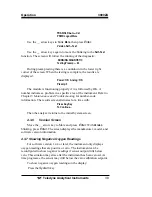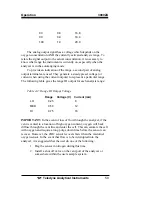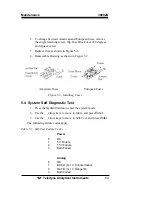
Operation
3000ZA
Teledyne Analytical Instruments
46
back to non-alarm conditions. This mode requires an alarm to
be recognized before it can be reset. In the non-latching
mode, the alarm status will terminate when process
conditions revert to non-alarm conditions.
8.
Are either of the alarms to be defeated?
9.
The defeat alarm mode is incorporated into the alarm circuit
so that maintenance can be performed under conditions
which would normally activate the alarms.
10.
The defeat function can also be used to reset a latched alarm.
(See procedures, below.)
If you are using password protection, you will need to enter your
password to access the alarm functions. Follow the instructions in
Section 4.3.3 to enter your password. Once you have clearance to
proceed, enter the Alarm function.
Press the
Alarm
button on the front panel to enter the Alarm
function. Make sure that
AL–1
is blinking.
AL—1 AL—2
Choose Alarm
Set up alarm 1 by moving the blinking over to AL–1 using the __
arrow keys. Then press
Enter
to move to the next screen.
AL—1 10 ppm HI
Dft—N Fs—N Ltch—N
Five parameters can be changed on this screen:
•
Value of the alarm setpoint,
AL–1 ####
ppm (oxygen);
value can be set from 0 to 10,000.00 ppm although the
sensor output is good only to 250 ppm
•
Out-of-range direction,
HI
or
LO
•
Defeated?
Dft–Y/N
(Yes/No)
•
Failsafe?
Fs–Y/N
(Yes/No)
•
Latching?
Ltch–Y/N
(Yes/No).
To define the setpoint, use the __ arrow keys to move the blinking
over to
AL–1 ####
. Then use the __ arrow keys to change the number.
Holding down the key speeds up the incrementing or decrementing.
(Remember, the setpoint units are ppm O
2
.)
Summary of Contents for 3000ZA
Page 24: ...Operational Theory 3000ZA Teledyne Analytical Instruments 12 Figure 2 3 Component Location...
Page 63: ...Trace Oxygen Analyzer Operation Teledyne Analytical Instruments 51...
Page 77: ...Trace Oxygen Analyzer Appendix Teledyne Analytical Instruments 1 SCFH 0 476 SLPM...
Page 81: ...Trace Oxygen Analyzer Index Teledyne Analytical Instruments...
















































